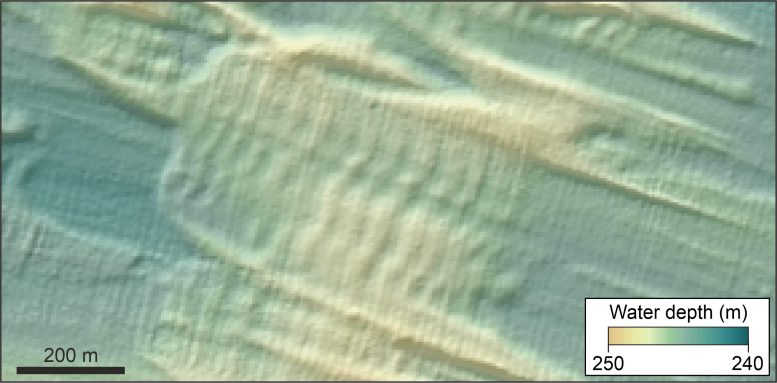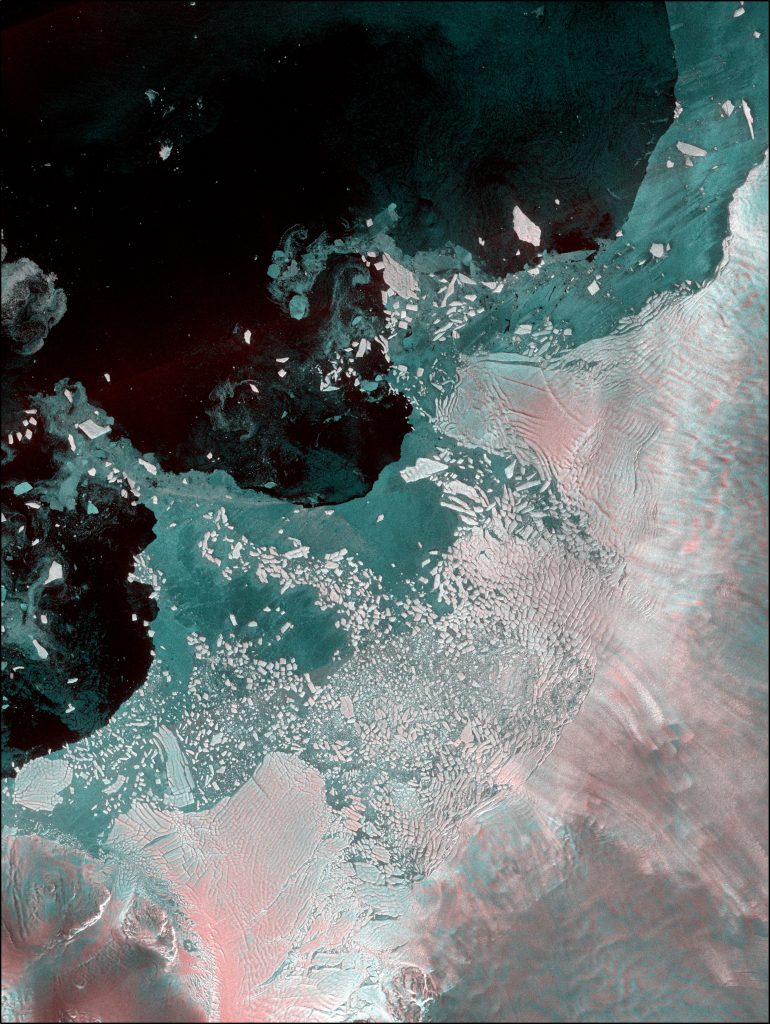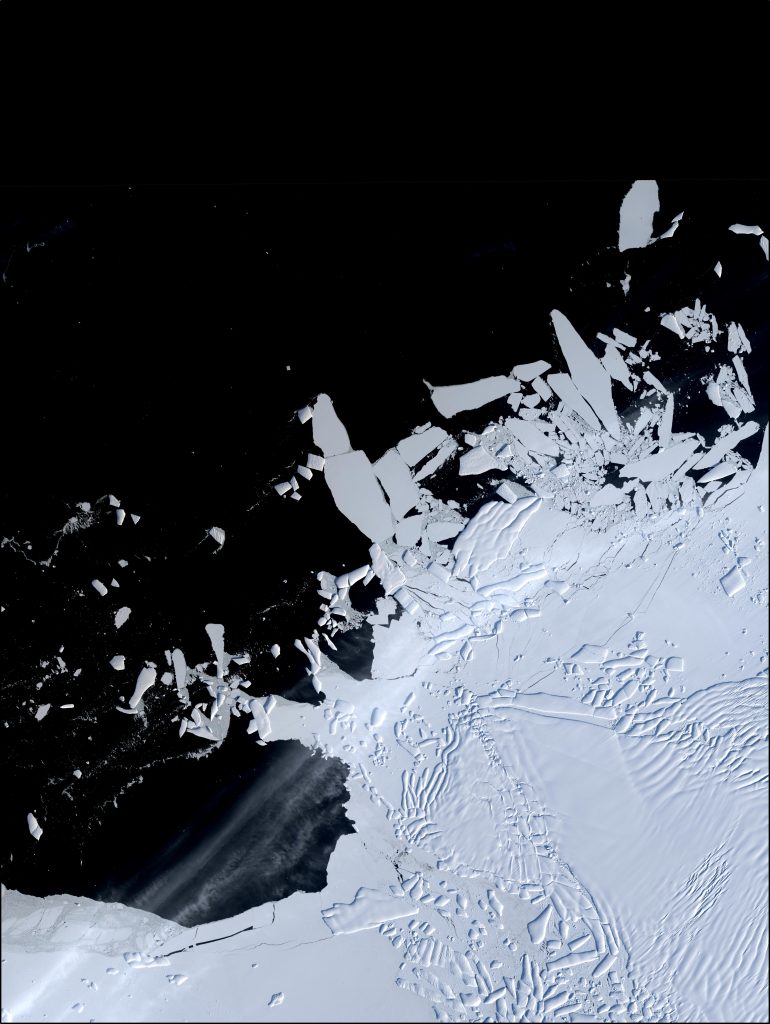
Landsat 8 image depicting the highly dynamic SCAR Inlet Ice Shelf, Antarctic Peninsula, and sea ice production offshore. Credit: NASA/USGS, processed by Dr. Frazer Christie, Scott Polar Research Institute, University of Cambridge
Scientists discover that during periods of global warming, ice sheets can retreat at a pace of up to 600 meters per day, which is 20 times quicker than the previous highest recorded rate of retreat.
An international team of scientists, headed by Dr. Christine Batchelor from Newcastle University in the United Kingdom, utilized high-resolution imagery of the ocean floor to uncover the rapid pace at which a former ice sheet that stretched from Norway receded at the end of the last Ice Age, approximately 20,000 years ago.
The team, which also included researchers from the universities of Cambridge and Loughborough in the UK and the Geological Survey of Norway, mapped more than 7,600 small-scale landforms called ‘corrugation ridges’ across the seafloor. The ridges are less than 2.5 m high and are spaced between about 25 and 300 meters apart.
These landforms are understood to have formed when the ice sheet’s retreating margin moved up and down with the tides, pushing seafloor sediments into a ridge every low tide. Given that two ridges would have been produced each day (under two tidal cycles per day), the researchers were able to calculate how quickly the ice sheet retreated.

Example of corrugation ridges on the seafloor of mid-Norway. Two ridges were produced each day by the tidal-induced vertical motion of the retreating ice sheet margin. Detailed bathymetric data. Credit: Kartverket
Their results, reported in the journal Nature, show the former ice sheet underwent pulses of rapid retreat at a speed of 50 to 600 meters per day.
This is much faster than any ice sheet retreat rate that has been observed from satellites or inferred from similar landforms in Antarctica.
“Our research provides a warning from the past about the speeds that ice sheets are physically capable of retreating at,” said Dr. Batchelor. “Our results show that pulses of rapid retreat can be far quicker than anything we’ve seen so far.”
Information about how ice sheets behaved during past periods of climate warming is important to inform computer simulations that predict future ice sheet and sea-level change.

Sentinel-1 image composite depicting the highly fractured and fast-flowing frontal margin of the Thwaites and Crosson ice shelves. Credit: Copernicus EU/ESA, processed by Dr. Frazer Christie, Scott Polar Research Institute, University of Cambridge
“This study shows the value of acquiring high-resolution imagery about the glaciated landscapes that are preserved on the seafloor,” said study co-author Dr. Dag Ottesen from the Geological Survey of Norway, who is involved in the MAREANO seafloor mapping programme that collected the data.
The new research suggests that periods of such rapid ice-sheet retreat may only last for short periods of time (days to months).
“This shows how rates of ice-sheet retreat averaged over several years or longer can conceal shorter episodes of more rapid retreat,” said study co-author Professor Julian Dowdeswell of the Scott Polar Research Institute, University of Cambridge. “It is important that computer simulations are able to reproduce this ‘pulsed’ ice-sheet behavior.”
The seafloor landforms also shed light into the mechanism by which such rapid retreat can occur. Dr. Batchelor and colleagues noted that the former ice sheet had retreated fastest across the flattest parts of its bed.

Landsat 8 image showing the heavily crevassed front of Thwaites Glacier, West Antarctica, and icebergs and sea ice offshore. Credit: NASA/USGS, processed by Dr. Frazer Christie, Scott Polar Research Institute, University of Cambridge.
“An ice margin can unground from the seafloor and retreat near-instantly when it becomes buoyant”, explained co-author Dr. Frazer Christie, also of the Scott Polar Research Institute. “This style of retreat only occurs across relatively flat beds, where less melting is required to thin the overlying ice to the point where it starts to float.”
The researchers conclude that pulses of similarly rapid retreat could soon be observed in parts of Antarctica. This includes at West Antarctica’s vast Thwaites Glacier, which is the subject of considerable international research due to its potential susceptibility to unstable retreat. The authors of this new study suggest that Thwaites Glacier could undergo a pulse of rapid retreat because it has recently retreated close to a flat area of its bed.
“Our findings suggest that present-day rates of melting are sufficient to cause short pulses of rapid retreat across flat-bedded areas of the Antarctic Ice Sheet, including at Thwaites”, said Dr. Batchelor. “Satellites may well detect this style of ice-sheet retreat in the near future, especially if we continue our current trend of climate warming.”
Reference: “Rapid, buoyancy-driven ice-sheet retreat of hundreds of metres per day” by Christine L. Batchelor, Frazer D. W. Christie, Dag Ottesen, Aleksandr Montelli, Jeffrey Evans, Evelyn K. Dowdeswell, Lilja R. Bjarnadóttir, and Julian A. Dowdeswell, 5 April 2023, Nature.
DOI: 10.1038/s41586-023-05876-1
Other co-authors are Dr. Aleksandr Montelli and Evelyn Dowdeswell at the Scott Polar Research Institute of the University of Cambridge, Dr. Jeffrey Evans at Loughborough University, and Dr. Lilja Bjarnadóttir at the Geological Survey of Norway. The study was supported by the Faculty of Humanities and Social Sciences at Newcastle University, Peterhouse College at the University of Cambridge, the Prince Albert II of Monaco Foundation, and the Geological Survey of Norway.
Article From & Read More ( 20 Times Quicker – Ice Sheets Can Collapse Far Faster Than Previously Thought Possible - SciTechDaily )https://ift.tt/bABD93i
Science
No comments:
Post a Comment